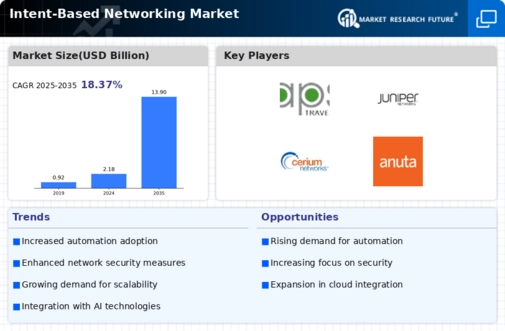Market Analysis
In-depth Analysis of Intent Based Networking Market Industry Landscape
In the last few years, the Intent-Based Networking (IBN) business has changed a lot. This is because automation and intelligence are becoming more important in network management. With Intent-Based Networking, network tasks are made easier and more automated. Administrators may specify high-level business goals, and the network architecture dynamically adjusts to meet them. This unique technique is gaining popularity as organizations seek methods to increase network agility, efficiency, and security. The growing technical complexity of today's networks drives the intent-based networking business. As organizations implement digital transformation, they require more dynamic and adaptive networks. Traditional networking approaches struggle to adapt, resulting in operational inefficiencies and increased security threats. Intent-Based Networking solves these problems by centralizing and policing network management. This method lets companies quickly adapt to changing business demands. Automation is another key factor in intent-based networking market dynamics. IBN technologies automate repetitive and time-consuming tasks, reducing human error and freeing up IT resources for critical projects. This efficiency enhancement appeals to organizations seeking to raise productivity and optimize network operations. As a result, firms in many industries are progressively realizing the importance of intent-based networking for operational success. Security is crucial in today's connected world, and Intent-Based Networking prevents network security breaches. The Internet Business Network (IBN) lets administrators design and execute security standards based on business objectives to build a more secure network architecture. This focus on security resonates with firms facing a rising threat environment, making intent-based networking a crucial part of cybersecurity efforts. The rise of cloud computing and hybrid and multi-cloud architectures also affect the intent-based networking industry. As more enterprises migrate workloads and applications to the cloud, consistent and automated network management is needed. Intent-Based Networking solutions govern on-premises and cloud networks from a unified platform, enabling seamless connectivity and uniform policy enforcement. Intent-based networking is changing due to innovation and vendor rivalry. Many technology vendors are joining the market, offering a variety of solutions with distinct capabilities and characteristics. Due to this competitiveness, IBN solutions are becoming increasingly complicated and innovative. As the market matures, organizations have more options to choose the Internet of Business (IBN) solution that best meets their needs and ambitions.
















Leave a Comment